 9 Steps to a successful school BYOD implementation – a blogpost by Sarah Cornelius which provides advice for schools moving to have pupils use their own devices to support their learning in the classroom. This sets out 9 steps which include ensuring that everyone understands what is hoped to be achieved and all the positive benefits which incorporating multiple types of device can bring to learning – but also recognising the challenge this poses, with suggestions as to how these challenges can best be resolved. It explains the need for everyone to have an understanding of device-neutral applications with a focus on the task to be accomplished, and users choosing the app or webtool which best meets the need specific to the user’s device. Also how helpful it is having a cloud-based platform which is common to all users – Scottish schools all have access to the range of tools and resources via Glow, providing every learner and member of staff with that cloud-based platform.
9 Steps to a successful school BYOD implementation – a blogpost by Sarah Cornelius which provides advice for schools moving to have pupils use their own devices to support their learning in the classroom. This sets out 9 steps which include ensuring that everyone understands what is hoped to be achieved and all the positive benefits which incorporating multiple types of device can bring to learning – but also recognising the challenge this poses, with suggestions as to how these challenges can best be resolved. It explains the need for everyone to have an understanding of device-neutral applications with a focus on the task to be accomplished, and users choosing the app or webtool which best meets the need specific to the user’s device. Also how helpful it is having a cloud-based platform which is common to all users – Scottish schools all have access to the range of tools and resources via Glow, providing every learner and member of staff with that cloud-based platform.
Category: BYOD
The problem is not the device
 “Quit blaming the devices” is a blogpost by John Spencer which sets out a reasoned discussion about varying views by teachers starting on the journey of having their pupils using mobile devices in their classrooms.
“Quit blaming the devices” is a blogpost by John Spencer which sets out a reasoned discussion about varying views by teachers starting on the journey of having their pupils using mobile devices in their classrooms.
http://www.spencerideas.org/2015/12/quit-blaming-devices.html
It’s not a technology issue
 It’s not a technology issue! A blogpost by Eric Sheninger which encourages educators to reflect on how they view mobile device use in the classroom. How do we as educators now use mobile devices, what example are we setting for our learners? How should we view their use, how do we change the culture of our school to embrace them as tools to support our learners in their engagement with their learning?
It’s not a technology issue! A blogpost by Eric Sheninger which encourages educators to reflect on how they view mobile device use in the classroom. How do we as educators now use mobile devices, what example are we setting for our learners? How should we view their use, how do we change the culture of our school to embrace them as tools to support our learners in their engagement with their learning?
“Technology still gets a bad rap in many education circles. Perception and lack of information influence the decision making process. This ends up resulting in the formation of rules and policies that severely restrict or prohibit student use of mobile technology and social media as tools to support and/or enhance learning.”
“The process of effectively integrating devices begins with our ability to model appropriate use while reinforcing student expectations for the role of mobile devices… to ensure that devices afford students the opportunity to support and/or enhance their learning”
Click on the link below to read the full blogpost
http://esheninger.blogspot.co.uk/2015/10/its-not-technology-issue.html
European Schoolnet Guide to BYOD for School Leaders
Bring Your Own Device (BYOD) Guide for School Leaders  – a new publication by the European Schoolnet’s Interactive Classroom Working Group (ICWG).
– a new publication by the European Schoolnet’s Interactive Classroom Working Group (ICWG).
“The guide is designed to provide school leaders, local education authorities and other decision makers with information on BYOD trends, options and examples from schools in European countries and in other parts of the world. The guide is intended to be a continuing source of information and further case studies will be added to keep on track with latest developments.”
An introduction to BYOT – Bring Your Own Technology – for parents
Bring Your Own Device or Bring Your Own Technology or Use Your Own Device
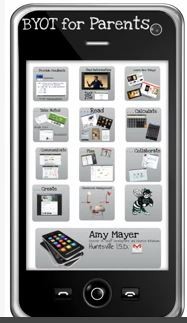 BYOT for Parents – an explanatory video about Bring Your Own Technology by US educator Amy Mayer, aimed at parents/carers, describing different ways in which mobile technology might be used in a classroom situation to support learning and teaching. It gives examples of situations and specific tools and how they could be used in an educational context. The examples are specific to a particular school district in the USA at a particular moment in time, however the principles (feedback, researching, collaborating, communicating, note-taking, creating, demonstrating understanding and more) can generally be applied elsewhere with different tools.
BYOT for Parents – an explanatory video about Bring Your Own Technology by US educator Amy Mayer, aimed at parents/carers, describing different ways in which mobile technology might be used in a classroom situation to support learning and teaching. It gives examples of situations and specific tools and how they could be used in an educational context. The examples are specific to a particular school district in the USA at a particular moment in time, however the principles (feedback, researching, collaborating, communicating, note-taking, creating, demonstrating understanding and more) can generally be applied elsewhere with different tools.
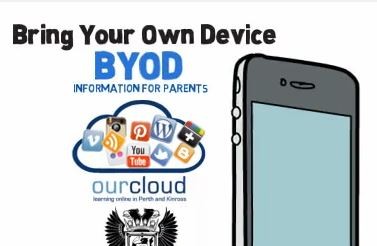 BYOD for Parents pkc – an explanatory video by Perth and Kinross Council explaining the introduction of Bring Your Own Device and what that means for learners in a classroom context.
BYOD for Parents pkc – an explanatory video by Perth and Kinross Council explaining the introduction of Bring Your Own Device and what that means for learners in a classroom context.
BYOD in the 21st Century – an short video by Canadian educator Marc-André Lalande presenting some of the advantages and limitations of this concept for education.
5 back to school bits of advice for smartphone-carrying pupils (1 for parents too)
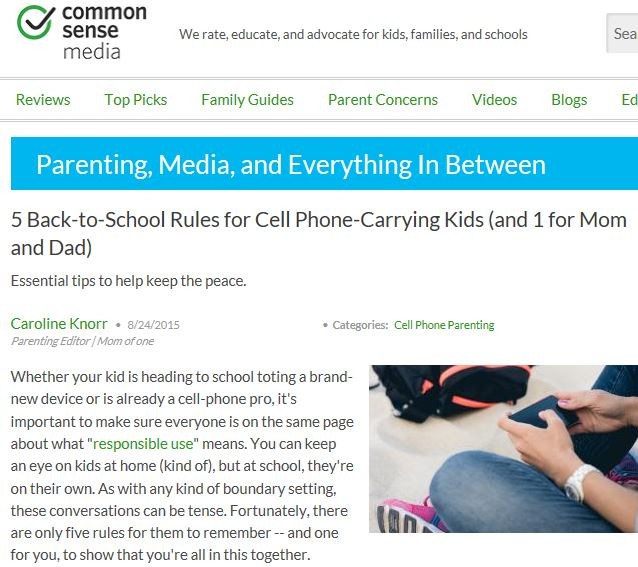 5 back to school bits of advice for smartphone-carrying pupils (and 1 for parents/carers too) – helpful guidelines from Common Sense Media for pupils who are starting back to school with their mobile device or smartphone. Links also to additional resources and games to help everyone make best use of their mobile devices.
5 back to school bits of advice for smartphone-carrying pupils (and 1 for parents/carers too) – helpful guidelines from Common Sense Media for pupils who are starting back to school with their mobile device or smartphone. Links also to additional resources and games to help everyone make best use of their mobile devices.
Connected Learning – the Preston Lodge High School example
Do you wonder how other schools are using mobile devices to support learning and teaching? Well, East Lothian Secondary Schools now offer wireless learning for all young people. This means that young people can use school or personal devices to access a very wide range of learning materials online. This new opportunity creates important new responsibilities for young people.
At Preston Lodge High School in East Lothian they’ve put together a guide and animated video explaining to pupils how they manage the use of the mobile devices brought by pupils. Some tools and resources they use may be specific to their school but the general principals and guidance may be found to be helpful to other schools to consider. You can see a description at the link below:
http://www.edubuzz.org/prestonlodge/2015/08/19/connected-learning/
You can also watch the Preston Lodge High School Connected Learning animated video below (or click on this link):
https://www.youtube.com/watch?v=Y_3rAiElRLM
Step by Step Guidance from Common Sense Education to Moving to Mobile Devices in Your School
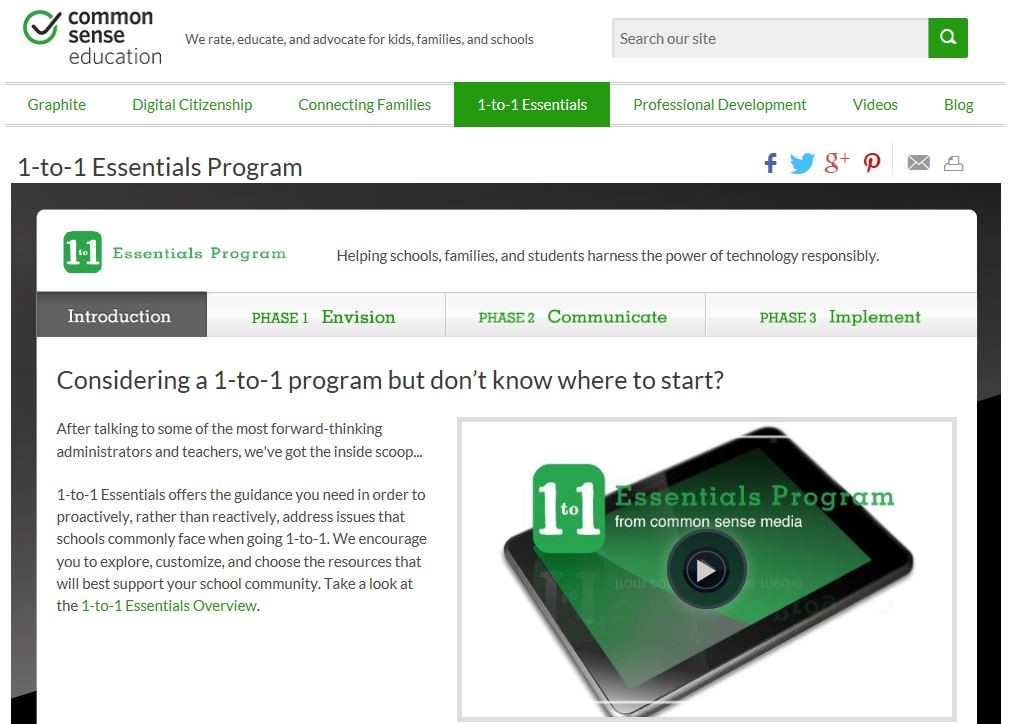 Considering 1-1 but don’t know where to start? CommonSense Education has put together a helpful step-by-step guide to help schools looking to see how best to implement the use of mobile devices in their school. This online resource includes guidance, tips and ideas, examples, videos, survey tools and much more. It’s all presented in such a way that you look at where your school is at right now, then look at the resources which best match your needs and aspirations for where you wish mobile learning in your school to reach. Then it guides you through identifying the issues, the key stakeholders (and how to involve them in decisions and planning) and offers advice and resources to help on your chosen path to making use of mobile devices to support learning and teaching in your school.
Considering 1-1 but don’t know where to start? CommonSense Education has put together a helpful step-by-step guide to help schools looking to see how best to implement the use of mobile devices in their school. This online resource includes guidance, tips and ideas, examples, videos, survey tools and much more. It’s all presented in such a way that you look at where your school is at right now, then look at the resources which best match your needs and aspirations for where you wish mobile learning in your school to reach. Then it guides you through identifying the issues, the key stakeholders (and how to involve them in decisions and planning) and offers advice and resources to help on your chosen path to making use of mobile devices to support learning and teaching in your school.
Using Mobile Devices as Classroom Response Tools
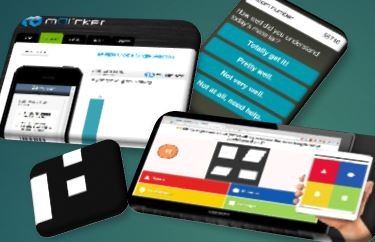 Classroom Response Tools for Assessment for Learning. There are several ways in which mobile devices can be used in a classroom setting to provide feedback to the teacher about every learner’s understanding of material being covered.
Classroom Response Tools for Assessment for Learning. There are several ways in which mobile devices can be used in a classroom setting to provide feedback to the teacher about every learner’s understanding of material being covered.
And there are a number of tools which can be used in tandem with mobile devices, regardless of the device (they can also be used by desktop computers, tablet devices or smart phones) – essentially an internet-connected device is all that’s required, though some also have device-specific apps which make their use even easier. So click on the link below to see the range of device-agnostic tools to support using mobile devices as classroom response tools, including Socrative, Kahoot, mQlicker, Tricider, Formative, The Answer Pad, Vizaroo, GoPollGo and Plickers (which works with only one device in the hands of the teacher):
https://blogs.glowscotland.org.uk/fa/ICTFalkirkPrimaries/pupil-response-devices/
Infographic Poster about the case for Mobile Learning
 The Case for Mobile Learning is a post with a visual infographic poster on e-Learning Infographics site which sets out statistics about the current and projected usage of mobile devices in terms of ownership as well as when and how they are used in any day. Although this is derived from information about the adult population, and impact mainly on businesses, it illustrates a direction of travel in society at large, upon which educational establishments may wish to reflect.
The Case for Mobile Learning is a post with a visual infographic poster on e-Learning Infographics site which sets out statistics about the current and projected usage of mobile devices in terms of ownership as well as when and how they are used in any day. Although this is derived from information about the adult population, and impact mainly on businesses, it illustrates a direction of travel in society at large, upon which educational establishments may wish to reflect.
Find more education infographics on e-Learning Infographics
